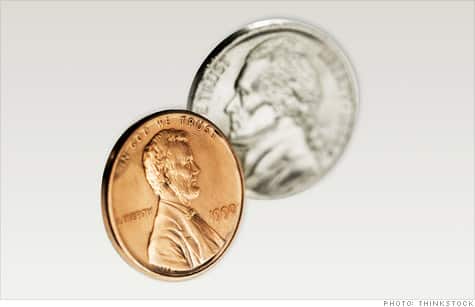Copper is derived from the Latin word cuprum, which means “from the island of Cyprus”. Copper has been put to use for at least 11,000 years according to archaeologists. Ancient people found copper in “nuggets and masses on the surface of the Earth, adjacent to streams, in the walls of canyons” (Lugaski, 1997, n.p.). Throughout the years copper has been used to make such things as pots, pans and even some crowns and headdresses in ancient times. The use of copper spread to Asia where “cultures and religions, such as Buddhism and Hinduism, used copper in the creation of fantastic inlays, embossed facades on palaces and temples, and ceremonial vessels” (Jewellery Supplier, 1999, n.p.). In recent times copper has been used to make armour, weapons, bells, and ornaments.
Nickel’s name comes from the German word for the mineral niccolite (kupfernickel) which means “Old Nick’s copper”. A Swedish Chemist named Axel Fredrik is credited for the discovery of Nickel in 1751. In today’s world “nickel is obtained from the mineral pentlandite” (Thomas Jefferson National Accelerator Facility – Office of Science Education, n.d., n.p.). Ontario, Canada is the world’s leading supplier of nickel. It is mined from the Sudbury region where it is believed that a meteor struck there along time ago.
Chemical Properties
Copper’s atomic number is 29 and its chemical symbol is  “Cu”. Copper’s natural state is a solid. The heat of fusion is 13 kJ mol-1, heat of vaporization is 304.6 kJ mol-1, and the heat of atomization is 338 kJ mol-1. Nickel’s Symbol: Ni Atomic Number: 28. Atomic Mass: 58.6934 amu. Melting Point: 1453.0 °C (1726.15 K, 2647.4 °F) Boiling Point: 2732.0 °C
“Cu”. Copper’s natural state is a solid. The heat of fusion is 13 kJ mol-1, heat of vaporization is 304.6 kJ mol-1, and the heat of atomization is 338 kJ mol-1. Nickel’s Symbol: Ni Atomic Number: 28. Atomic Mass: 58.6934 amu. Melting Point: 1453.0 °C (1726.15 K, 2647.4 °F) Boiling Point: 2732.0 °C
Physical Properties
Copper is a mineral that is both malleable and ductile. This means that it can be bent and shaped, whether hot or cold, without cracking and that it can be drawn out into thin wire. Copper has a metallic lustre and is opaque. Copper has no cleavage it only fractures. Pure copper is the most efficient conductor of electricity since it is second only to silver which is too expensive for this sort of use. Copper is also a good conductor of heat that makes it useful for cookware, refrigerators, and radiators. It is resistant to corrosion; however, if the air around it is often damp it will eventually become coded with “patina” which is a green film that stops all further corrosion. The melting point of copper is 1083.4 degrees Centigrade and it boils at 2567 degrees Centigrade.
Nickel has a metallic, lustrous, silvery tinge to it. It is a silvery with metal with a nice polish to it. Nickel can come in a variety of forms including foil, powder, flakes, sheet, wire, mesh, and rods. Nickel has a melting point of 1453 degrees centigrade and a boiling point of 2732 degrees centigrade. Nickel is a hard mineral, it is also ductile, malleable, and is to some extent ferromagnetic. Nickel, like copper, is also a decent conductor of heat and electrical current. Nickel is a member of the transitional elements, which is made up of iron and cobalt metals. In some cases nickel compounds are considered to be dangerously toxic or carcinogenic.
References
Ford, W.E. (1932). Dana’s Textbook of Mineralogy (4th ed.). London: Chapman & Hall.
Hunt, Kraus & Ramsdell. (1936). Mineralogy (3rd ed.). York: The Maple Press Company.
Jeellery Supplier. (1999). Retrieved March 9, 2004, from http://www.jewelrysupplier.com/2_copper/copper_History.htm.
Lugaski, Tom. (1997). Retrieved March 11, 2004, from http://www.unr.edu/sb204/geology/copper2.html.
Maxwell, John A. (1968) Rock and Mineral Analysis. Ottawa: Interscience Publishers.
Thomas Jefferson National Accelerator Facility – Office of Science Education. (n.d.). Retrieved March 9, 2004 from http://education.jlab.org/itselemental/ele028.html.
Winter, Mark. (2003). Nickel. Retrieved March 11, 2004, from http://www.webelements.com/webelements/elements/text/Ni/key.html

It does not give me the chemical properties of nickel! Please take a little time to fix this.